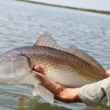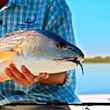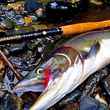Preparedness was never my thing. There’s a reason I made it to Webelo, but didn’t matriculate farther through the Boy Scout system. You can only show up at the den meeting without your little scarf slider so many times before it sinks in.
This just isn’t for me.
As I slogged my way half a mile or so through the mist and the knee-deep muskeg to intercept a stream that connects two boreal lakes in far eastern Alaska, the same thought occurred to me. The stream, rumored to hold grayling up to 20 inches, was proving tough to locate, and the fetid aroma that I kept releasing from the muck with every tortuous step was making my eyes water and my head swim.
Maybe, I thought, this just isn’t for me.
Then the stream—more of a deep, dark channel—appeared through the ether. It ran quietly through the willows, snaking its way from one small lake to the next. In the distance, a loon crooned and the sound bounced ominously between the low cloud cover and the dark water.
More Like This
Armed with a sweet little 3-weight Mystic Reaper and a box full of dries, it sure looked I’d stumbled into the perfect scenario—me, massive grayling and daylight that seemed to last forever. I watched the water for a few minutes and was a bit bothered that nothing was rising, even though a strong gray drake hatch was popping.
I tied on a size 12 Adams, a decent representation of the hatch, and started placing casts tight to both banks. Nothing. I cast upstream and got perfect drifts. Nothing. Downstream with a subtle skate. Nothing.
But at the rumored 20 inches, I wasn’t deterred. Fish that big are predators, even grayling. A small streamer should work, right?
I tied a size 10 yellow Woolly Bugger to the 4x tippet—light enough for the supple Reaper to cast, but heavy enough to get down a bit. I flipped the little streamer across the channel and let it swing. As the line straightened out, below me, I felt a bump. I stripped line in and another bump, this one stronger. I paused the fly and let it sink a bit.
One. Two. Three. Strip.
Fish on.
It was no 20-incher—but it was a solid fish, fast and feisty. I saw a flash in the dark water and started to strip it closer. The little 3-weight doubled over appreciably, and I giggled just a little bit. Wait until a big one hits, I thought.
As I got the fish closer, I realized it wasn’t a grayling at all, but small pike, maybe 15 inches. How it nabbed the little ‘bugger without slicing the 4x tippet with its tiny pike teeth is a mystery, but it helped explain the lack of rising fish. If anything bigger than this guy was lurking in the dark water, any grayling foolish enough to rise to a dry fly might very well end up as lunch.
I released the little pike, and dug through my sling pack. This called for a bigger fly. Oh, and I was going to need heavier tippet. And, I thought, if a 9-foot 7-weight fly rod would just appear out of nowhere, that would be awesome, too.
As I noted, preparation isn’t my thing.
Time to take inventory.
I had four spools of tippet attached to the outside of the sling, the heaviest of which was 2x. Tucked into the recesses of the sling was a mishmash collection of streamers, mostly salvaged from previous trout trips, including a larger cone-head black leech—maybe a size 6. That would work. I hoped.
Casting the heavier fly wasn’t easy with the light, short 3-weight, but with a big loop and an overhand heave, I got the fly into the water and let it drift downstream. The line stretched tight at the tail end of the swing, and I gave the leech a quick strip. Nothing. One little pike, and I was expecting a fish on every cast.
I stripped the leech in, and kept “casting” as I worked my way down the channel toward the lower lake. After about 20 minutes—and literally five minutes short of me just giving up—I hooked a much bigger fish judging by the brief flash I saw through the tea-stained water. But within seconds, the 2x tippet predictably failed, and the sore-mouthed pike swam off to sulk, my leech stuck firmly in its jaws. I was thrilled, but then I realized that I was just armed with a 3-weight. Even with a solid hook-set, could I bring a bigger fish in?
I looked back across the sticky, gooey muskeg meadow at the trail down off the sketchy gravel road—it would take me 30 minutes just to get across this muck. There, behind the aspens and across the patch of raspberries that I traversed, pepper spray in hand, I could imagine all my pike gear, tucked safely away in the back of the truck. Probably another 15 minutes. Then I’d have to come back.
Be prepared? Yeah. I’d arrived without my scarf slider. Again.
My kingdom for a spool of Maxima 40-pound mono.
To hell with it, I thought. I reached around for my clippers and cut the tapered 4x leader down to what I guessed was a 30-pound butt section. This left me a leader about four feet long, but I didn’t care. If I was to land any of these pike, I’d need the girth, not the length.
I tied another salvaged streamer to the “tippet”—this one an old black ‘bugger, maybe size 8—and repeated my chuck-and-duck cast, moving down the channel toward the lake. I’d put the fly up against the far bank, let it swing in the soft current and then give it a twitch or two before stripping it in.
As I got closer to the lower lake—a big pond, actually—the water got deeper … and darker. The muskeg was more sponge-like, and I felt like I was actually floating on it rather than walking on it. If I fell through, I imagined myself being sucked into pike hell, disappearing into the black mud, never to be seen or heard from again.
I got to the mouth of the channel and launched the best cast of the day into the black water. I let the streamer sink, and gave it a tug. Then, behind me, about 20 feet upstream, a big swirl and a splash drew my attention. Something significant had just made a swipe at something that looked like food.
With my line tight, I lifted the black ‘bugger from the water and magically flipped it over my head behind me, landing it within inches of the swirl, a cast I couldn’t repeat again if I had all day to do it. I gave the streamer a twitch, and watched as something massive simply inhaled it. I strip-set the fly, and the “tippet” miraculously held. The 3-weight bent nervously as the fish rocketed out from under the cutbank and took off upstream.
The reel—Redington’s new no-drag Zero—screamed as the pike tore through the dark water, headed, apparently, for the upper lake. I palmed the little trout reel as best I could, mustering enough energy to slow the fish down, but the rod still pumped up and down and the big pike resorted to head shakes and rolls as it tried to spit the fly.
I balanced on the floating stretch of muskeg, doing my best to fight the last thing I expected. This was no 20-inch grayling. It was a pike that probably exceeded 30 inches and ate my precious grayling for breakfast, lunch, dinner and dessert.
It took time. Lots of time. But I got the fish close enough to where I could grab the knot where the leader and the fly line come together. I was able to sort of guide the big fish over to the shallows, where it splashed and kicked up mud and grass. Kneeling on the floating muskeg, I quickly snapped a couple of photos before plucking the fly from the fish’s toothy maw with a pair of hemostats. I reached down to lift the giant fish from the water, but as soon as I touched it, it flopped and bounced again, this time into shallow water. I reached for it one last time, but it slithered off through the grass, creating a wake until it reached the dark water and disappeared altogether. I checked the viewfinder of the camera, just to make sure all that just happened and I hadn’t made it up. There, in 14 megapixels, was the proof.
I sat back on my heels and took a look around me. The improbability of the moment was soaking in.
Preparation or adaptability?
The first one is easier. But the second makes for a better story.
































Comments